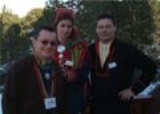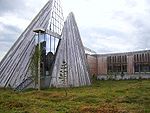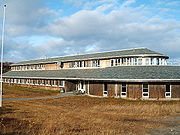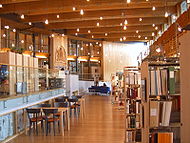
Sami Parliament of Norway
Encyclopedia
The Sami Parliament of Norway is the representative body for people of Sami
heritage in Norway
. It acts as an institution of cultural autonomy for the indigenous Sami people
.
The Parliament was opened on 9 October 1989. The seat is in Kárášjohka
(Karasjok). It currently has 39 representatives, who are elected every four years by direct vote from 7 constituencies. The last election was in 2009. Unlike in Finland, the 7 constituencies cover all of Norway. The current president is Egil Olli
who represents the Labour Party
.
In 1978, the Norwegian Water Resources and Energy Directorate
published a plan that called for the construction of a dam and hydroelectric power plant that would create an artificial lake and inundate the Sami
village of Máze. This plan was met by strong opposition from the Sámi, and resulted in the Alta controversy
. As a result of the controversy, the Norwegian government held meetings in 1980 and 1981 with a Sámi delegation appointed by the Norwegian Sámi Association
, the Sámi Reindeer Herders’ Association of Norway and the Norwegian Sámi Council. The meetings resulted in the establishment of a committee to discuss Sámi cultural issues, and the Sámi Rights Committee addressing Sámi legal relations. The latter proposed a democratically elected body for the Sámis, resulting in the Sámi Act of 1987. In addition, the Sámi Rights Committee resulted in the 1988 amendment of the Norwegian Constitution, and the adoption of the Finnmark Act in 2005.
The Sámi Act (1987:56), stipulating the responsibilities and powers of the Norwegian Sami Parliament, was passed by the Norwegian Parliament on 12 June 1987 and took effect on 24 February 1989. The first session of the Sami Parliament was convened on 9 October 1989 and was opened by King Olav V
.
 The Norwegian Sámi Parliament plenary (dievasčoahkkin) has 39 representative elected by direct vote from 7 constituencies. The plenary is the highest body in the Sami Parliament and it is sovereign in the execution of the Sami Parliaments duties within the framework of the Sámi Act. The representatives from the largest party (or from a collaboration of parties) form an executive council (Sámediggeráđi), and selects a president and vice-president. The executive council is responsible for executing the roles and responsibilities of the parliament between plenary meetings. In addition there are multiple thematic committees addressing specific cases.
The Norwegian Sámi Parliament plenary (dievasčoahkkin) has 39 representative elected by direct vote from 7 constituencies. The plenary is the highest body in the Sami Parliament and it is sovereign in the execution of the Sami Parliaments duties within the framework of the Sámi Act. The representatives from the largest party (or from a collaboration of parties) form an executive council (Sámediggeráđi), and selects a president and vice-president. The executive council is responsible for executing the roles and responsibilities of the parliament between plenary meetings. In addition there are multiple thematic committees addressing specific cases.

 The Sami Parliament of Norway is located in Kárášjohka
The Sami Parliament of Norway is located in Kárášjohka
(Northern Sami
: Kárášjohka; Norwegian
: Karasjok), and the building was inaugurated on 2 November 2000. There are also offices in Guovdageaidnu (Kautokeino), Unjárga (Nesseby), Gáivuotna (Kåfjord), Divtasvuodna (Tysfjord), and Snåase (Snåsa).
The town of Kárášjohka
is considered an important center of Sami culture in Norway. Approximately 80% of the town's population is Sami-speaking, and the town also hosts Sami broadcasting stations and several public and private Sami institutions such as the Sami Museum and the Sami chamber of commerce (Sami Trade and Industry).
In 2006 about 115 people were employed.
are: "(1) to serve as the Sámis’ elected political body to promote political initiatives and (2) to carry out the administrative tasks delegated from national authorities or by law to the Sámi Parliament.".
The extent of responsibility that was assigned and transferred from the Norwegian government at the time of establishment was modest (1989). However, more responsibilities have been added including :
 One of the responsibilities is ensuring that the section 1–5 of the Saami Act (1987:56) is upheld, i.e., that the Sami languages
One of the responsibilities is ensuring that the section 1–5 of the Saami Act (1987:56) is upheld, i.e., that the Sami languages
and Norwegian
continue to have the same status. A good example of this is the current situation in Tysfjord
, where speakers of Lule Sami cannot conduct their official business in that language as the municipality
has not provided anyone who can speak it to assist them. This is the only municipality in Norway
where speakers of that language should theoretically be able to speak it with officials, but this has not come to fruition; therefore, the Saami Parliament must fight for this cause with Tysfjord and must bring it to the attention of the Norwegian Government, if Tysfjord fails to rectify the situation.
The total budget for the Norwegian Sami Parliament has been about:
In addition the parliament controls the 75 million NOK in "Samefolkets fond". A fund established in 2000 as compensation for the governments Norweganization policy.
reported that the Progress Party
had "the need for abolishing the parliament", as part of its charter
(vedtektsfestet).
Regarding the architecture and for photographs of the building, interior and exterior, see:
On gender balance in the parliament:
Sami people
The Sami people, also spelled Sámi, or Saami, are the arctic indigenous people inhabiting Sápmi, which today encompasses parts of far northern Sweden, Norway, Finland, the Kola Peninsula of Russia, and the border area between south and middle Sweden and Norway. The Sámi are Europe’s northernmost...
heritage in Norway
Norway
Norway , officially the Kingdom of Norway, is a Nordic unitary constitutional monarchy whose territory comprises the western portion of the Scandinavian Peninsula, Jan Mayen, and the Arctic archipelago of Svalbard and Bouvet Island. Norway has a total area of and a population of about 4.9 million...
. It acts as an institution of cultural autonomy for the indigenous Sami people
Sami people
The Sami people, also spelled Sámi, or Saami, are the arctic indigenous people inhabiting Sápmi, which today encompasses parts of far northern Sweden, Norway, Finland, the Kola Peninsula of Russia, and the border area between south and middle Sweden and Norway. The Sámi are Europe’s northernmost...
.
The Parliament was opened on 9 October 1989. The seat is in Kárášjohka
Karasjok
Kárášjohka or is a village and municipality in Finnmark county, Norway. The administrative centre of the municipality is the village of Karasjok.-Name:Karasjok is a Norwegianized form of the Sámi name Kárášjohka...
(Karasjok). It currently has 39 representatives, who are elected every four years by direct vote from 7 constituencies. The last election was in 2009. Unlike in Finland, the 7 constituencies cover all of Norway. The current president is Egil Olli
Egil Olli
Egil Andreas Olli is a Norwegian politician for the Labour Party. In September 2007, he became President of the Sami Parliament of Norway when he replaced Aili Keskitalo after she stepped down upon the collapse of the coalition she was heading...
who represents the Labour Party
Norwegian Labour Party
The Labour Party is a social-democratic political party in Norway. It is the senior partner in the current Norwegian government as part of the Red-Green Coalition, and its leader, Jens Stoltenberg, is the current Prime Minister of Norway....
.
History
In 1964, the Norwegian Sámi Council was established to address Sámi matters. The members of the body were appointed by state authorities. This body was replaced by the Sami Parliament.In 1978, the Norwegian Water Resources and Energy Directorate
Norwegian Water Resources and Energy Directorate
The Norwegian Water Resources and Energy Directorate is a Norwegian government agency established in 1921. It is under the Ministry of Petroleum and Energy and regulates the country's water resources and energy supply. Its mandate includes contingency planning for floods, serving as a centre of...
published a plan that called for the construction of a dam and hydroelectric power plant that would create an artificial lake and inundate the Sami
Sami people
The Sami people, also spelled Sámi, or Saami, are the arctic indigenous people inhabiting Sápmi, which today encompasses parts of far northern Sweden, Norway, Finland, the Kola Peninsula of Russia, and the border area between south and middle Sweden and Norway. The Sámi are Europe’s northernmost...
village of Máze. This plan was met by strong opposition from the Sámi, and resulted in the Alta controversy
Alta controversy
The Alta controversy refers to a political controversy in Norway in the late 1970s and early 1980s concerning the construction of a hydroelectric power plant in the Alta river in Finnmark, Northern Norway.-Key events:...
. As a result of the controversy, the Norwegian government held meetings in 1980 and 1981 with a Sámi delegation appointed by the Norwegian Sámi Association
Norwegian Sami Association
The Norwegian Sami Association , also known as NSR, is the largest Sámi organization in Norway. The association was founded in 1968.-Purpose:The NSR actively runs cultural, social, and informational work through local groups and Sami associations. In total 24 Sami associations are attached to the...
, the Sámi Reindeer Herders’ Association of Norway and the Norwegian Sámi Council. The meetings resulted in the establishment of a committee to discuss Sámi cultural issues, and the Sámi Rights Committee addressing Sámi legal relations. The latter proposed a democratically elected body for the Sámis, resulting in the Sámi Act of 1987. In addition, the Sámi Rights Committee resulted in the 1988 amendment of the Norwegian Constitution, and the adoption of the Finnmark Act in 2005.
The Sámi Act (1987:56), stipulating the responsibilities and powers of the Norwegian Sami Parliament, was passed by the Norwegian Parliament on 12 June 1987 and took effect on 24 February 1989. The first session of the Sami Parliament was convened on 9 October 1989 and was opened by King Olav V
Olav V of Norway
Olav V was the king of Norway from 1957 until his death. A member of the House of Schleswig-Holstein-Sonderburg-Glücksburg, Olav was born in the United Kingdom as the son of King Haakon VII of Norway and Queen Maud of Norway...
.
Organization

Presidents
- Ole Henrik MaggaOle Henrik MaggaOle Henrik Magga is a Sámi linguist and politician from Kautokeino, Norway.-As a linguist:As a linguist, Ole Henrik Magga is best known for his work on syntax...
: 1989-1993, representing Norwegian Sami AssociationNorwegian Sami AssociationThe Norwegian Sami Association , also known as NSR, is the largest Sámi organization in Norway. The association was founded in 1968.-Purpose:The NSR actively runs cultural, social, and informational work through local groups and Sami associations. In total 24 Sami associations are attached to the...
. - Ole Henrik Magga: 1993-1997, representing Norwegian Sami Association.
- Sven-Roald NystøSven-Roald NystøSven-Roald Nystø is a Lule Sami politician from Storå in Tysfjord.Nystø was the president of the Norwegian Sami Parliament for two terms, from 1997 to 2005, representing the Norwegian Sámi Association. Before he became president of the Sami Parliament, he was Vice-President under Ole Henrik Magga...
: 1997-2001, representing Norwegian Sami Association. - Sven-Roald Nystø: 2001-2005, representing Norwegian Sami Association.
- Aili KeskitaloAili KeskitaloAili Keskitalo is a Norwegian Sami politician representing Norwegian Sámi Association . In 2005 she became president of the Sami Parliament of Norway, the third in its history and the first female President of any Sámi Parliament....
: 2005-2007, representing Norwegian Sami Association. - Egil OlliEgil OlliEgil Andreas Olli is a Norwegian politician for the Labour Party. In September 2007, he became President of the Sami Parliament of Norway when he replaced Aili Keskitalo after she stepped down upon the collapse of the coalition she was heading...
: 2007-2009, representing Labour PartyNorwegian Labour PartyThe Labour Party is a social-democratic political party in Norway. It is the senior partner in the current Norwegian government as part of the Red-Green Coalition, and its leader, Jens Stoltenberg, is the current Prime Minister of Norway....
. - Egil Olli: 2009-, representing Norwegian Labour Party.
Location


Karasjohka
Karasjohka river joins Anarjohka downstream of Karigasniemi and forms the famous salmon fishing Tana river . Karasjok municipality in Finnmark, Norway is situated along the upper river basin of the Deatnu / Tana river, and its tributaries Anarjohka and Karasjohka, and includes large tracts of the...
(Northern Sami
Northern Sami
Northern or North Sami is the most widely spoken of all Sami languages. The speaking area of Northern Sami covers the northern parts of Norway, Sweden and Finland...
: Kárášjohka; Norwegian
Norwegian language
Norwegian is a North Germanic language spoken primarily in Norway, where it is the official language. Together with Swedish and Danish, Norwegian forms a continuum of more or less mutually intelligible local and regional variants .These Scandinavian languages together with the Faroese language...
: Karasjok), and the building was inaugurated on 2 November 2000. There are also offices in Guovdageaidnu (Kautokeino), Unjárga (Nesseby), Gáivuotna (Kåfjord), Divtasvuodna (Tysfjord), and Snåase (Snåsa).
The town of Kárášjohka
Karasjohka
Karasjohka river joins Anarjohka downstream of Karigasniemi and forms the famous salmon fishing Tana river . Karasjok municipality in Finnmark, Norway is situated along the upper river basin of the Deatnu / Tana river, and its tributaries Anarjohka and Karasjohka, and includes large tracts of the...
is considered an important center of Sami culture in Norway. Approximately 80% of the town's population is Sami-speaking, and the town also hosts Sami broadcasting stations and several public and private Sami institutions such as the Sami Museum and the Sami chamber of commerce (Sami Trade and Industry).
In 2006 about 115 people were employed.
Building
The building was designed by the architects Stein Halvorsen & Christian Sundby, who won the Norwegian government's call for projects in 1995, and inaugurated in 2005. The government called for a building such that “the Sámi Parliament appears in a dignified way” and “reflects Sámi architecture.” Hence the peaked structure of the Plenary Assembly Hall resembles the tipis the Sami used as a nomadic culture. The parliament building also houses a Sami library focussing on books in the Sami language or on Sami topics, and the Sami chamber of commerce, 'Sami Trade and Industry'.Responsibilities
The parliament works with political issues it considers relevant or of interest to the Sami people. The responsibilities of the Sami Parliament in NorwayNorway
Norway , officially the Kingdom of Norway, is a Nordic unitary constitutional monarchy whose territory comprises the western portion of the Scandinavian Peninsula, Jan Mayen, and the Arctic archipelago of Svalbard and Bouvet Island. Norway has a total area of and a population of about 4.9 million...
are: "(1) to serve as the Sámis’ elected political body to promote political initiatives and (2) to carry out the administrative tasks delegated from national authorities or by law to the Sámi Parliament.".
The extent of responsibility that was assigned and transferred from the Norwegian government at the time of establishment was modest (1989). However, more responsibilities have been added including :
- Management of the Sámi Development Fund, which is used for grants to Sámi organizations and Sámi duodjiDuodjiDuodji is a centuries old Sami handicraft, that dates back to a time when the Sami were far more isolated from the outside world than they are today. Duodji tools and clothing accoutrements served their purpose to be functional and useful, however this does not mean that the Sami handicraft is...
(1989). - Responsibility for the development of the Sámi language in Norway, including allocation of funds to Sami language municipalities and counties (1992).
- Responsibility for Sámi culture with a Sámi culture, including a fund from the Norwegian Council for Cultural Affairs (1993).
- Protection of Sámi cultural heritage sites (1994).
- Development of Sámi teaching aids, including allocation of grants for this purpose (2000).
- Election of 50% of the members to the board in the Finnmark EstateFinnmark ActThe Finnmark Act transferred about 95% of the area in the Finnmark county in Norway to the inhabitants of Finnmark. This area is managed by the Finnmark Estate agency....
(2006).

Sami languages
Sami or Saami is a general name for a group of Uralic languages spoken by the Sami people in parts of northern Finland, Norway, Sweden and extreme northwestern Russia, in Northern Europe. Sami is frequently and erroneously believed to be a single language. Several names are used for the Sami...
and Norwegian
Norwegian language
Norwegian is a North Germanic language spoken primarily in Norway, where it is the official language. Together with Swedish and Danish, Norwegian forms a continuum of more or less mutually intelligible local and regional variants .These Scandinavian languages together with the Faroese language...
continue to have the same status. A good example of this is the current situation in Tysfjord
Tysfjord
Tysfjord or Divtasvuodna is a municipality in Nordland county, Norway. It is part of the Ofoten traditional region. The administrative centre of the municipality is the village of Kjøpsvik...
, where speakers of Lule Sami cannot conduct their official business in that language as the municipality
Municipality
A municipality is essentially an urban administrative division having corporate status and usually powers of self-government. It can also be used to mean the governing body of a municipality. A municipality is a general-purpose administrative subdivision, as opposed to a special-purpose district...
has not provided anyone who can speak it to assist them. This is the only municipality in Norway
Norway
Norway , officially the Kingdom of Norway, is a Nordic unitary constitutional monarchy whose territory comprises the western portion of the Scandinavian Peninsula, Jan Mayen, and the Arctic archipelago of Svalbard and Bouvet Island. Norway has a total area of and a population of about 4.9 million...
where speakers of that language should theoretically be able to speak it with officials, but this has not come to fruition; therefore, the Saami Parliament must fight for this cause with Tysfjord and must bring it to the attention of the Norwegian Government, if Tysfjord fails to rectify the situation.
Funding
Funding is granted by the Norwegian state over various national budget lines. But the parliament can distribute the received funds according to its own priorities. In the Norwegian government the main responsibility for Sami affairs, including the allocation of funds, is the Ministry of Labour and Social Inclusion.The total budget for the Norwegian Sami Parliament has been about:
- 2008: 311 million NOK.
- 2007: 275 million NOK (ibid).
- 2006: 260 million NOK.
In addition the parliament controls the 75 million NOK in "Samefolkets fond". A fund established in 2000 as compensation for the governments Norweganization policy.
Salaries and other expenses
None of the MPs are receive full-time salary from the parliament.Elections
To be eligible to vote or be elected to the Norwegian Sami Parliament a person needs to be included in the Sámi census. In order to be included the following criteria must be met as stipulated in Section 2–6 of the Sámi Act: "Everyone who declares that they consider themselves to be Sámi, and who either has Sámi as his or her home language, or has or has had a parent, grandparent or great-grandparent with Sámi as his or her home language, or who is a child of someone who is or has been registered in the Sámi census, has the right to be enrolled in the Sámi census in the municipality of residence." Results of the last election:Cooperation with the state government
In the Norwegian central administration the coordinating organ and central administrator for Sámi issues is the Department of Sámi and Minority Affairs in the Ministry of Labour and Social Inclusion. This department also coordinates interministerial and Nordic state cooperation regarding Sámi issues. The Sámi Parliament is consulted when state government issues affect Sámi interests.Political parties that want to abolish the parliament
In 2011, KlassekampenKlassekampen
Klassekampen is a Norwegian daily newspaper, which styles itself as "the daily left-wing newspaper".Klassekampen was founded in 1969 with a Marxist-Leninist-Maoist platform. Until recently, it was owned by The Workers' Communist Party...
reported that the Progress Party
Progress Party (Norway)
The Progress Party is a political party in Norway which identifies as conservative liberal and libertarian. The media has described it as conservative and right-wing populist...
had "the need for abolishing the parliament", as part of its charter
Charter
A charter is the grant of authority or rights, stating that the granter formally recognizes the prerogative of the recipient to exercise the rights specified...
(vedtektsfestet).
See also
- Sami parliamentsSámi politicsSámi politics refers to politics that concern the indigenous Sámi people in Norway, Sweden, Finland and Russia. In a more narrow sense, it has come to indicate the government of Sámi affairs by Sámi political institutions...
- Sámi parliament of FinlandSami Parliament of FinlandThe Sami Parliament of Finland is the representative body for people of Sami heritage in Finland. The parliament consists of 21 elected mandates...
- Sámi parliament of SwedenSami Parliament of SwedenThe Sami Parliament of Sweden is the representative body for people of Sami heritage in Sweden. It acts as an institution of cultural autonomy for the indigenous Sami people.-History:...
- Sámi parliament of Finland
- Elections in NorwayElections in NorwayNorway elects its legislature on a national level. The parliament, the Storting , has 169 members elected for a four year term by the proportional representation in multi-seat constituencies.Norway has a multi-party system, with numerous parties in which no one party often has a chance of gaining...
- KárášjohkaKarasjohkaKarasjohka river joins Anarjohka downstream of Karigasniemi and forms the famous salmon fishing Tana river . Karasjok municipality in Finnmark, Norway is situated along the upper river basin of the Deatnu / Tana river, and its tributaries Anarjohka and Karasjohka, and includes large tracts of the...
External links
Regarding the architecture and for photographs of the building, interior and exterior, see:
- Sametinget (Sami Parliament of Norway), on the SkyscraperCity website
- Parliament for the Sami people / SH arkitekter, on the Modern Architectural Concepts blog
On gender balance in the parliament:
- Norway’s Sámi Parliament: Getting to 50-50, on the International Museum of Women website

